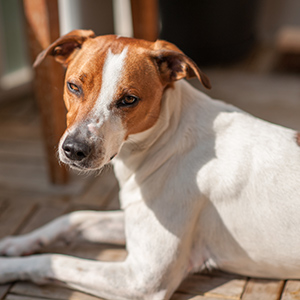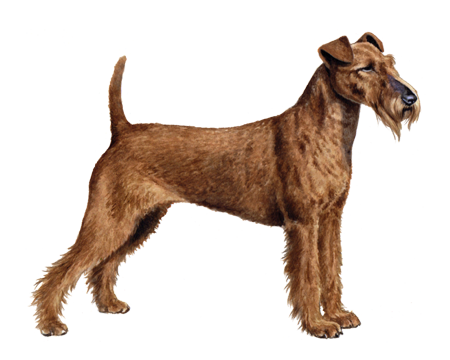
Danish Swedish Farmdog
The Danish Swedish Farmdog is a versatile working breed and lovable family pet. These intelligent pups have outgoing personalities and enough energy to keep up with their humans all day long. But when it's time to cuddle up on the couch, you don't have to ask these little dogs twice.
Interested in discovering if your dog is a Danish Swedish Farmdog?
Check out Wisdom Panel's DNA tests.

Danish Swedish Farmdog Traits
General Appearance
The small Danish Swedish Farmdog has a compact, rectangular-shaped body.
Coat and Colouring
This breed's coat is smooth, short, and harsh. Danish Swedish Farmdogs are predominantly white with patches of tan, brown, or black (or a combination of colors) on the body and head. Some dogs have flecking in their coats.
Distinctive Physical Traits
Danish Swedish Farmdogs have triangular-shaped heads that are small in proportion to their bodies. The breed's dark, rounded eyes give an attentive, kind expression. Rose or button ears fold just above the skull. The tail can be long or naturally short and stumpy.
Danish Swedish Farmdog Temperament
Danish Swedish Farmdogs are playful, rambunctious, and usually friendly dogs. Though bred to work, they make affectionate family pets. They're great with kids and typically get along with other dogs.
Danish Swedish Farmdogs need regular exercise, but they know how to enjoy downtime (preferably curled up in a lap), too. Because they're slower to mature than other breeds, you can expect this breed's "puppy phase" to last longer than most.
Left to their own devices, Danish Swedish Farmdogs sometimes decide to occupy themselves with undesirable or destructive behaviors, such as chewing or digging. And since old habits die hard, these hunters and ratters may chase small pets or wildlife.


Danish Swedish Farmdog History
An older breed, the Danish Swedish Farmdog originated in Eastern Denmark and Southern Sweden and is now prevalent throughout Scandinavia. These dogs have been known by several names—including the Old Danish Fox Terrier, Scanian Terrier, Danish Pinscher, and, simply, the Rat Dog. Though the Danish Swedish Farmdog bears a striking resemblance to the Russell Terrier and Fox Terrier, it actually belongs to the Pinscher family.
Throughout history, Danish Swedish Farmdogs served as guardians, hunters, and vermin catchers. But as the world became more modernized and dependent on machinery, the need for small working dogs like the Danish Swedish Farmdog decreased. As a result, this breed nearly vanished. But true to its feisty terrier ancestry, the Danish Swedish Farmdog held on.
In 1987, the Danish and Swedish Kennel Clubs recognized the breed—followed by the United Kennel Club in 2008 and the American Kennel Club in 2011.
Danish Swedish Farmdog Care
Nutrition
Danish Swedish Farmdogs require a diet formulated for their specific life stage (e.g., puppy, adult, senior). Experts also recommend a food designed for small breeds. Such diets have the appropriate blend of nutrients and a smaller kibble size that is easier for little dogs to chew and digest.
All dogs can become overweight if they eat too many calories. So, keep an eye on how much you're feeding, and don't forget to account for treats. In general, treats should make up no more than 10% of a dog's calories.
Grooming
The Danish Swedish Farmdog's short coat is a breeze to maintain. Just brush your pup occasionally to remove any loose hair and bathe them if they get into anything dirty or stinky.
Their grooming routine should also include regular nail trims and ear cleanings. Lastly, get them started on a good dental hygiene program. Small dogs like the Danish Swedish Farmdog are particularly susceptible to dental issues due to their small mouths and crowded teeth. At-home dental care and professional cleanings are both essential to this breed's overall health.
Exercise
These energetic dogs need daily physical and mental exercise to stay happy and healthy. They love a challenge, so dog sports—including agility, lure coursing, tracking, nose work, and competitive obedience—work well for this breed. Danish Swedish Farmdogs also enjoy brisk walks with their humans and playtime in a fenced backyard.
Training
Danish Swedish Farmdogs are very intelligent and highly trainable. And because of their working dog background, they're generally eager to please. Positive reinforcement with treats or a favorite toy is often an effective approach for training this breed.
Danish Swedish Farmdog Genetic Health Conditions
-
Chondrodystrophy (CDDY) and Intervertebral Disc Disease (IVDD) Risk
Chondrodystrophy (CDDY) is a skeletal disorder characterized by shortened limbs and abnormal early degeneration of the spinal discs, or intervertebral disc disease (IVDD), which predisposes to disc herniation.
-
Hyperuricosuria
Hyperuricosuria (HUU) is a condition that predisposes affected dogs to the formation of urinary stones, such as kidney or bladder stones.
-
MDR1 Medication Sensitivity
The MDR1 gene variant causes a defect to a drug pumping protein that plays an important role in limiting drug absorption and distribution (particularly to the brain). Dogs with the MDR1 variant may have severe adverse reactions to some commonly used medications.
-
Primary Lens Luxation
Primary Lens Luxation (PLL) is a condition that can cause the lens of the eye to become loose and eventually displace. The disorder is caused by degeneration of the fibers that hold the lens in place.
Knowing if your Danish Swedish Farmdog is a carrier or at-risk for these conditions can help you and your veterinarian plan for your pup's lifelong care. With Wisdom Panel™ Premium, you can get results for over 200 genetic health tests.
Breed Group
Terrier
The Terrier Group ancestors were bred to hunt and kill vermin. They are often characterized as feisty and energetic dogs whose sizes range from fairly small to much larger.
Resources
http://www.fci.be/Nomenclature/Standards/356g02-en.pdf
https://www.akc.org/dog-breeds/danish-swedish-farmdog/
Reviewed 5 September 2020 by Annette Louviere, DVM































































